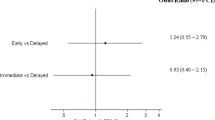Abstract
We evaluated the adverse reactions (AR) rate produced in patients to see if any difference related to the diferent chemotoxicities of two low-osmolality contrast media (CM), could be detected. We compared the AR rate intravenous administration for brain or body computed tomography (CT) enhancement of either the ionic CM ioxaglate 320 mgI/ml or the non-ionic iopamidol 300 mgI/ml at a dose of 0.8 gI/kg. Three hundred and thirty patients (164 ioxaglate, 166 iopamidol) were studied according to a randomized double-blind design. AR reported by the patients (subjective) and/or observed by the radiologist (objective) were recorded by the radiologist on the patients record card. Laboratory test were performed prior to and 24 h after contrast administration.
Fifty-nine mild to moderate AR occurred in 30 patients (18.3%) receiving ioxaglate, 4 mild to moderate AR occurred in 2 patients (1.2%) receiving iopamidol (P < 0.05). No severe AR occurred in either group.
The results of our study are comparative to the available evidence from 16 comparative randomized trials of iopamidol versus ioxaglate both after intraarterial and intravenous administration that gave an overall odds ratio of 3.9 [confidence interval (CI) 95% = 3.1–4.9].
The diagnostic efficacy of the two CM was comparable. This study showed that the non-ionic CM iopamidol was better tolerated than the ionic ioxaglate after intravenous administration. We conclude that the chemotoxicity of the molecule influences the AR when CM with comparable osmolality are administered.
Similar content being viewed by others
References
Rosati D, De Haen C (1991) Considerations on the research and development of new X-ray contrast media: A critical appraisal. In Katayama H, Brasch RC (eds) New Dimensions of Contrast Media. Int. Congress Series 976, Excerpta Medica, Amsterdam, pp 29–34
Swanson DP, Thrall JH, Shetty PC (1984) Evaluation of intravascular low-osmolality contrast agents. Clin Pharm 5: 877–891
Cook TD, Leviton LC (1980) Reviewing the literature: a comparison of traditional methods with meta-analysis. J Pers 48: 5217–5223
Ellenberg SS (1988) Meta-analysis: the quantitative approach to research review. Semin Oncol 15: 472–481
L'Abbé KA, Detsky AS, O'Rourke K (1987) Meta-analysis in clinical research. Ann Intern Med 107: 228–233
Jusuf S, Collins R, Peto R (1984) Why do we need some large, simple trials? Stat Med 409–420
Scholtz ME, Scatos VJ, Myburgh DP (1988) Comparison between a low-osmolar ionic (ioxaglate) and a low-osmolar non-ionic (iopamidol) contrast agent in cardiac imaging. S Afr Med J 73: 168–171
Soiva M, Hekali P, Keto P, Karumo J, Salonen O, Heikkila J (1991) Iohexol, Ioxaglate and Iopamidol in coronary angiography. A double-blind comparative study of 300 patients. Australas Radiol 35: 109–111
Gertz EW, Wisneski JA (1990) Adverse reactions with arterial administration of low osmolality contrast media: prospective randomized multicenter study. JACC 15: 135 A
Feldman RL (1990) A comparison of heparinazied low osmolality ionic and non-ionic contrast media in 500 patients undergoing cardiac angiography. Clin Cardiol 13: 794–796
Wisneski JA, Gertz EW, Dahlgren M, Muslin A (1990) Comparison of low osmolality ionic (Ioxaglate) versus non-ionic (Iopamidol) contrast media in cardiac angiography. Am J Cardiol 13: 794–796
Peck RJ, Bull MJ, Cumberland DC (1985) Comparison of low osmolar contrast media in cardiac angiography. Br J Radiol 58: 1177–1178
Klinke WP, Grace M, Miller R, Naqvi SZ, Roth D, Roy L (1989) A multicenter randomized trial of ionic (Ioxaglate) and non-ionic (Iopamidol) low-osmolality contrast agents in cardiac angiography. Clin Cardiol 689–696
Wolf KJ, Steidle B, Banzer D, Seyferth W, Keysser R (1983) Comparative evaluation of low osmolar contrastmedia in (femoral) arteriography. In Taenzer V, Zeitler E (eds) Contrast media in urography, angiography and computerized tomography. ROFO 118 Suppl: 102–106
Doyon D, Ducot B, Halimi PH,Spira A, Noviant Y, Jacolot A, Lopez-Ibor L (1987) Comparative trial of Hexabrix (320 mg iodine/ml), Iohexol (300 mg iodine/ml) and Iopamiron (300 mg iodine/ml) in cerebral and spinal angiography: a preliminary report. Br J Radiol 60: 671–675
Mitsumori M, Hayakawa K, Abe M (1991) ECG changes during cerebral angiography; a comparison of low osmolality contrast media. Eur J Radiol 13: 55–58
Foord KD, Kaye B, Howard J, Cumberland DC (1985) Comparison of the side-effects of low-osmolar media in intravenous urography. Clin Radiol 36: 379–380
Loughran CF (1986) Clinical intravenous urography: comparative trial of ioxaglate and iopamidol. Radiology 161: 455–458
Bjork L, Zachrisson BF (1986) Low dose urography: a clinical comparison of three low osmolar (ratio 3) contrst media. Acta Radiol Diagn 27: 557–559
Lonstaff AJ, Henson JHL (1985) Bronchospasm following intravenous injection of ionic and non-ionic low-osmolality contrast media. Clin Radiol 36: 651–653
Eyes BE, Goldman M, Nixon TE, Scally J, Brown A (1987) Low dose low osmolar intravenous urography. Clin Radiol 38: 403–405
Campbell RD, Flemming BK, Maso WF, Jackson SA, Hirsch DJ, MacDonald KJ (1990) A comparative study of the nephrotoxicity of Iohexol, Iopamidol and Ioxaglate in peripheral angiography. J Can Assoc Radiol 73: 168–171
Brismar J, Jacobsson BF, Jorulf H (1991) Miscellaneous Adverse Effects of Low-versus High-Osmolality Contrast Media: a Study Revised. Radiology 179: 19–23
Kinnison ML, Powe NR, Steinberg EP (1989) Results of Randomized Controlled Trials of Low-versus High-Osmolality Contrast Media. Radiology 170: 381–389
Author information
Authors and Affiliations
Additional information
Correspondence to: Carlo Del Favero
Rights and permissions
About this article
Cite this article
Del Favero, C., Rossini, G. & Martegani, A. A comparison of iopamidol and ioxaglate in CT enhancement. Eur. Radiol. 3, 77–82 (1993). https://doi.org/10.1007/BF00173529
Issue Date:
DOI: https://doi.org/10.1007/BF00173529




